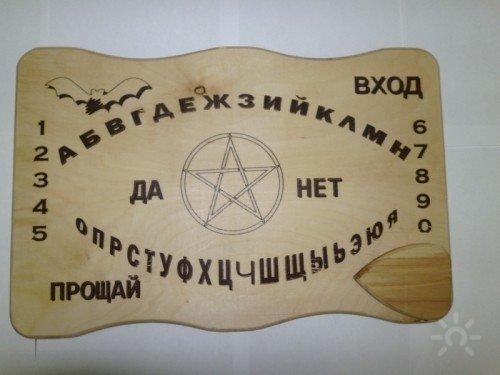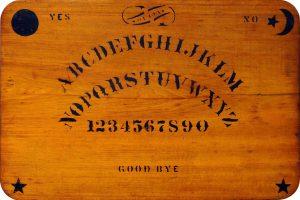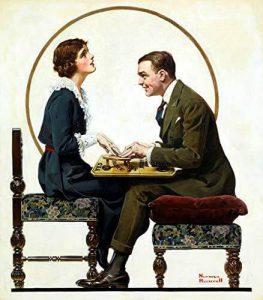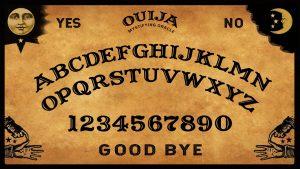
Ouija board - history, operation, and how the board works
Contents:
First, a few words about what popular speedji boards are and what they look like. The most common flat boards are marked:
- alphabet letters
- numbers 0-9,
- with the words: "yes", "no", sometimes "hello" and "goodbye"
- various symbols (for example, sun and crescent) and graphics are less common.
The game uses tips (a small piece of wood or plastic in the shape of a heart or triangle) as a movable pointer for writing messages during a session. Participants place their fingers on the pointer as it slides across the board to pronounce words. Ouija is a trademark of Hasbro (the world's second largest toy company).

The original spidge board created in 1890.
Spiritualists believed that the dead could communicate with the living - reportedly in 1886 they used a tablet very similar to a modern Ouija board to supposedly communicate with spirits faster.
After commercial introduction by businessman Elijah Bond on July 1, 1890, the Ouija board was considered an innocent party game that has nothing to do with the occult.
A Scientific Explanation of How Ouija Board Works
Ouiji's belief in paranormal and supernatural phenomena has been criticized by the scientific community and called pseudoscience... The work of the array can be sparingly explained. unconscious movements of people controlling the indicator, a psychophysiological phenomenon called ideomotor effect (The ideomotor effect refers to people who move or act without awareness.)
History of the Ouija Board
One of the earliest mentions of the writing technique used on the Ouija chalkboard can be found in China around 1100 in historical records of the Song Dynasty. This technique was known as "writing on the board" fuji. The use of this way of reading signs as an obvious means of necromancy and communication with the spirit world continued under special rituals and control. This was the central practice of the Quanzhen School until it was banned by the Qing Dynasty. Several complete scriptures of the Daozansang are believed to be written on the blackboard. According to one author, similar writing techniques were practiced in ancient India, Greece, Rome, and medieval Europe.
Modern time
As part of the spiritualist movement, the media ("communication with ghosts") began to use various means of communication with the dead. Post-American Civil War media carried out significant activities, ostensibly allowing survivors to contact their missing relatives.
Ouija board as a commercial salon game

Couple Playing Ouiju - Norman Rockwell, 1920
Elijah Bond, a businessman, had the idea to patent a game that was sold along with a board with an alphabet printed on it. The board was similar to the previous ones used by the media to communicate with ghosts. Bond applied for patent protection on May 28, 1890, and is thus credited as the inventor of the Ouija board. Date of issue of the patent - February 10, 1891
Elijah Bond employee, William Fuld, took over the production of gadgets. In 1901, Fuld began producing his own cymbals called Ouija. Charles Kennard (founder of the Kennard Novelty Company, which made Fuld's plates and where Fuld worked as a finisher) claimed that he learned the name "Ouija" from his use of the tablet and that the ancient Egyptian word means "luck." ... When Fuld took over the production of planks, he popularized the more widely accepted etymology.
Religious criticism of the Ouija board
From the very beginning, the seance board was criticized by several Christian denominations. For example Catholic answers, a Catholic Christian apologetic organization, states that "The seance board is harmful because it is a form of divination."
In addition, Catholic bishops in Micronesia have called for a ban on the use of plaques and have warned parishes that they are talking to demons using tablets for seances. In their pastoral letter, the Dutch Reformed Churches urged their communicators to avoid seance boards as this is an "occult" practice.
Today most Christian religions consider Ouija tablets to be one of the the most popular and dangerous accessories for spiritualism, used by the medium to communicate not with ghosts, but in fact with ... demons and the devil.
Game Rules, Preparation and Tips - How to Use the Ouija Board
Using an Ouija board can be fun. Some people think this is a gateway to another world and warn against using a plaque, but many people see it as harmless entertainmentespecially if you don't take it too seriously.
Christians they warn of the consequences use it and indicate that it is an occult object.
Below are a few tips and rules for playing spey, for people who believe a little in the "power" of the board.

Specie board pattern with moon and sun symbols
First, preparation
- Gather your friends... From a technical point of view, Ouija can be played alone, but one of the basic rules is that you cannot play alone, so you must play with at least one person. The more people you collect, the more noise and noise that will confuse ghosts.
- Take care of the mood... Before contacting the “other side,” try to cheer yourself up by dimming the lights, using candles, and lighting incense.
- It is best to try it in the evening or early in the morning.
- Remove any distractions. There should be no loud music, noise from the TV and running of children. The game requires your undivided attention to be successful.
- Turn off your phones! Ringing the phone during a game breaks the atmosphere and spoils the mood.
- Prepare the place... According to the original instructions for the game, place the board on the knees of both participants with their knees touching. When there are more people, we can sit in a circle so that everyone has access to the indicator and the board.
A few tips to get you started
- Neutral place... Consider using the Ouija board in a neutral location - it is often not recommended to use it in your own home.
- Be patient... Sometimes the ghost takes a minute to warm up. You may not get an answer right away. Do not give up.
- The myths about "moving the pointer to warm up" mean nothing. The answer comes from the spirit, not the pointer — some ghosts can move the pointer faster than others.
- Sometimes the pointer moves quickly and sometimes very slowly. If getting a message from a whiteboard feels like waiting for a phone call, don't get angry. Wait or close the board and continue a little later.
- Be polite and stay calm.... If you are talking with a very communicative spirit, talk to him! Be friendly. This will encourage him / her to collaborate with you. You may not get the answers you want. This is not the spirit or the fault of the government. Anger or violence will simply ruin the atmosphere of the board and room.
- Just start... It is better not to overwhelm the spirit with long and difficult questions.
- Your first questions should have simple and short answers, for example:
- How many ghosts are in the room?
- You are in a good mood?
- What is your name?
- Chalkboard symbols... Some tablets have symbols - the sun and the moon tell you which spirit is in contact with you. If it comes from the sun, that is good; if it comes from the moon, that is bad. If you have an evil spirit, thank him for the time and say goodbye. When the indicator misses the goodbye, it means that the evil spirit is gone.
- Be careful with what you ask for... The last thing you want to think about is imminent death all night long. If you do not want to know the answer to a question, do not ask it. But if you do decide to ask about your future, remember that this will be a joke. Like us mortals, spirits do not see the future.
- Don't ask stupid questions - the ghost might not want to waste time. Not to mention how long it takes to write an answer!
- Don't ask for physical signs. It's just a request for trouble.
- End of session... If at any point you get scared or feel like the session is getting out of hand, just close the board by hovering the pointer over “Goodbye” and say, for example, “We're ending the meeting. Rest in peace".
As soon as we play
- Choose Wednesday... Designate one person to "control" the game and ask all questions - this will prevent chaos and facilitate the course of the game. Also assign someone to write down the answers where the marker stops.
- All players should be able to ask a question. Ponder the questions one at a time, but ask the medium to direct them personally to the board.
- Put your fingers on the tip... Ask all players to carefully place their index and middle fingers on the pointer. Move it slowly and focus on what you want to ask. Press your fingers into it, but without much effort; if you hold it too tightly, the pointer stops moving just as easily.
- Develop an introductory ritual... It can be anything - a prayer, a greeting, or even trinkets scattered around you.
- Let the medium greet the spirits and confirm that only positive energy is welcome.
- If you want to talk to a deceased relative, keep something important (something personal) nearby.
- Ask a question... They should (especially at the beginning) be simple, uncomplicated.
- If your ghost shows that he is angry, it is best to end the game and continue later.
- If you start getting rude or vulgar responses, don't be discouraged and don't respond with rude behavior. Don't yell if you're too scared, just say goodbye to the ghosts and complete the game.
- concentrate... For the best and most effective results, all players should clear their minds and focus on the question asked.
- Every player must be serious and respectful. If you have a friend who laughs or asks you to ask funny questions, reprimand him or throw him out of the room.
- Watch the pointer move... Sometimes it moves very quickly, but more often it moves slowly - if everyone is focused and attentive, the hand should take off slowly.
- Make sure no player moves the pointer on their own - if so, pay attention to them.
- End your sessions... If the prompt starts doing eights or counting from Z to A or 9 to 0, end the activity with goodbye. Each of these three things means that the ghost is trying to escape the board. It is very important to say goodbye to ghosts. You wouldn't want to be suddenly dumped, would you?
- Ask the medium to say it is time to end the session and move the clue over the goodbye symbol on the chalkboard.
- Of course, if you enjoy spending time in the shower, say, "Goodbye!" and wait for the board one by one to go to goodbye.
- Pack the game in a box.
Sources of
- https://en.wikipedia.org/wiki/Ouija
- https://www.wikihow.com/Use-a-Ouija-Board
Joy
Man bu malumotni deyarli ohirigaca uqidim Va yoqdi uzimdeyam qiziqiw bo Ln qilip kuriwni xihlamayman Cunki amerikada bir qiz wunday qilip ohiri ulip qolipti